ANSWER - Tide propagation in a sloping bottom converging banks estuary
Context
Cette page fait partie de la démarche collaborative ANSWER , dont l'objectif est de faire collaborer scientifiques et grand public autour du domaine de l'eau.
Cette fiche fait suite à la fiche "Propagation d'une onde dans un estuaire à pente du fond inclinée" mais traite de la propagation d'une onde dans un estuaire à gabarit rectangulaire dont la section se rétrécie linéairement vers l'amont et dont la pente du fond est également linéaire.
This page is part of the collaborative approachANSWER , whose goal is to make scientists and general public collaborate in the field of water.
This sheet is a continuation of the "Propagation d'une onde dans un estuaire à pente du fond inclinée" but deals with the propagation of a wave in an estuary with a rectangular section whose section narrows linearly upstream and whose slope of the bottom is also linear.
Mathematical modeling of wave propagation phenomenon in an estuary
We will start from the one-dimensional Saint-Venant equations system, which will have been linearized to study the deformation of a wave during its propagation along a schematic estuary.
The linearization of this system will lead to an equation that will be solved directly, thus providing the temporal variation of the water level and the average celerity per section.
We will study 4 configurations:
- frictionless propagation with upstream boundary condition of open exit
- total reflection at the downstream boundary of the estuary and propagation without friction
- propagation with slight friction and upstream boundary condition of open exit
- propagation with strong friction and upstream boundary condition of open exit
We will take into account in this example a channel of rectangular section which narrows from downstream (the sea) to upstream (the river), a constant linear slope ascending towards the bottom and a convergence of the banks.
We will compare the results obtained by these analytical solutions with those obtained with TELEMAC2D two-dimensional finite element hydrodynamic computation code.
Hierarchy of simplifying hypotheses
The simplifications that follow allow us to develop a linear model of propagation of a wave within a simplified geometry domain, corresponding to a bottom slope canal, which can approach a schematic inside which spreads a surge wave.
'Navier-Stokes'
- → incompressible fluid
- → integration in a calculation section (rectangular channel) ==> Saint-Venant 1D
- → negligible acceleration
- → linearized friction
- → negligible acceleration
- → integration in a calculation section (rectangular channel) ==> Saint-Venant 1D
Expression of the simplified model
From the above assumptions, consider a rectangular cross-sectional channel with a constant bottom slope and a constant bank convergence rate.
Soit :
- $ h(x,t) $ water level
- $ u(x,t) $ flow mean velocity of the flow in the section $ S(x)=b(x)H(x) $
- $ Q(x,t)=S(x,t)u(x,t) $ discharge at section $ x $
- $ b(x)=b_0\dfrac{ x }{ x_0 } $ canal width which varies linearly with the abscisse, $ b_0 $ is the canal width at abscisse $ x_0 $ upstream of the estuary. $ p_b=b_0/x_0 $
- $ H(x)=H_0\dfrac{ x }{ x_0 } $ canal depth which varies linearly with the abscisse. $ p_f=H_0/x_0 $
- $ f $ linearized roughness coefficient
The equations governing the phenomenon are the linearized 1D Saint-Venant equations.
$ \begin{cases} b\dfrac{ \partial h }{ \partial t }+ \dfrac{ \partial Q }{ \partial x }=0 } \\ \\ \dfrac{ \partial Q }{ \partial t }+gS \dfrac{ \partial h }{ \partial x }+fQ=0 \end{cases} $
Deriving the first equation with respect to time and the second with respect to space and eliminating the common term, we obtain:
$ -b\dfrac{ \partial^2 h }{ \partial t^2 }+ g\dfrac { \partial }{ \partial x }\left[\Big S\dfrac{ \partial h }{ \partial x }\right]\Big +f\dfrac{ \partial Q }{ \partial x}=0 $
we are going to suppose that $ h $ is of the form $ h=A(x)e^{-i\sigma t} $. Deriving, we obtain :
$ \dfrac{ \partial h }{ \partial t}=(-i\sigma) A(x) e^{-i\sigma t} = -i\sigma h \qquad et \qquad \dfrac{ \partial^2 h }{ \partial t^2}=-\sigma^2 h $
By reporting these values in the equation above :
$ x^2\dfrac{ \partial^2 h }{ \partial x ^2}+2x\dfrac{ \partial h }{ \partial x} + \left[\Big \sigma (\sigma+fi) \right] \dfrac{ 1}{gp_f}} xh=0 $
Posons:
$ k^2=\dfrac{ \sigma^2}{ gH} \text{ wave number et }<br /> k_f^2=\sigma (\sigma+fi) \dfrac{ x_0}{ gH_0}\right] $
This term is a constant
Moreover, the friction can be expressed as follows :
$ f=\dfrac{8}{3\pi}\dfrac{g}{K^{2}{H_m^{4/3}}}\left| U_m \right| $ avec :
- $ K $ is the Strickler coefficient close to 0.002 - 0.003
- $ H_m $ the mean depth
- $ U_m $ the mean speed on a period
'Note' : this equation shows us that the distribution of the wave height is independent of the linear convergence rate of banks $ p_b $, but depends on the height of the water average $ H_0 $.
Analytical solution
We recognize a Bessel type equation:
$ x^2y''+(2p+1) x y'+(\alpha^2x^{2r}+\beta^2)y=0 $
The solution of this equation is given by:
$ y=x^{-p} \left[ c_{1} J_{P/r} (\alpha x^{r}/r) + c_{2} Y_{P/r} (\alpha x^{r}/r) \right] $
The fonctions $ J_{P/r} $ and $ Y_{P/r} $ are fonctions de Bessel first and second kind respectively.
In our case, we have : $ p=1/2, \beta=0, \alpha^2=k_f^2 , r=1/2 $ with $ P=\sqrt{p^2-\beta^2}=0 $
where:
$ h(x)=\dfrac{ 1 } { \sqrt x} \left[ c_{1} J_{1} (2k_f\sqrt x)+c_{2} Y_{1} (2k_f\sqrt x) \right]e^{-i\sigma t} $
The equation of momentum allows us to calculate the velocity $ u(x,t): $
$ b\dfrac{ \partial h } { \partial t}+\dfrac{ \partial }{ \partial x} (bHu)=0<br /> $
also:
$ bHu=i\sigma \dfrac{ b_0 } { x_0}e^{-i\sigma t} \int_{x} \sqrt x \left[ c_{1} J_{1} (2k_f \sqrt x)+c_{2} Y_{1} (2k_f \sqrt x) \right]\, \mathrm dx $
Given: $ z=2k_f \sqrt x $, il vient : $ dz=k_f \dfrac{1}{\sqrt x} dx $ et $ dx= \dfrac{z}{2k_f^2}dz $
By substituting these expressions in the previous equation, we obtain:
$ bHu= \dfrac{ b_0 } { x_0} \dfrac{ i\sigma} { 4k_f^3} e^{-i\sigma t} \int_{x} z^2 \left[ c_{1} J_{1} (z)+c_{2} Y_{1} (z) \right]\, \mathrm dz $
To calculate this integral, we use the following recurrence relation:
$ \dfrac{d}{dx} (x^n J_{n}(x))=x^n J_{n-1}(x) $, de même pour $ Y_{n}(x) $
We obtain :
$ u=i\sigma \dfrac{ 1} { k_f} \dfrac{x_0} { H_0} \dfrac{1} { x} \left[ c_{1} J_{2} (2k_f \sqrt x )+c_{2} Y_{2} (2k_f \sqrt x ) \right] e^{-i\sigma t} $
Summary: expression of the final analytical solution
In summary, the analytical expression expressing the variation of the water level and the mean velocity in any section of the domain are given by the following equations:
$ h(x,t)=\Re \Bigl(\left \dfrac{ 1} { \sqrt x} [ c_{1} J_{1} (2k_f \sqrt x)+c_{2} Y_{1} (2k_f \sqrt x) \right] e^{-i\sigma t}\Bigr) $
$ u(x,t)=\Re \Bigl( i\sigma \dfrac{ 1} { k_f} \dfrac{x_0} { H_0} \dfrac{1} { x} \left[ c_{1} J_{2} (2k_f \sqrt x) + c_{2} Y_{2} (2k_f \sqrt x) \right] e^{-i\sigma t}}\Bigr) $
Starting from the general expressions of $ h(x,t) $ et de $ u(x,t) $, we can determine the solution by setting 2 boundary conditions. We will consider the following two cases:
- propagation of an incoming wave from downstream (right) to upstream of the domain with open boundary condition at the upstream end (left)
- reflection of the same incoming wave from downstream (right) to upstream with total reflection at the upstream end (left)
Configuration n°1 : estuary without roughness - radiation boundary condition
We impose 2 boundary conditions to determine the two integration constants.
- an entering boundary condition at the entrance from the right side $ h(x_1,t)=A(x_1,t) e^{-i\sigma t}=a(x_1,t)e^{i(kx_1 -\sigma t)}=a(x_1,t)e^{i\phi} \quad\forall t $
- an exit boundary condition of Sommerfeld radiation type :
$ h(x,t)=a(x_0) e^{i\phi } $
Deriving this expression, we get:
$ \dfrac{ dh }{ dx }=e^{i\phi}\dfrac{ da }{ dx }+iae^{i\phi}\dfrac{ d\phi }{ d x } $
Each term expresses a process:
- taking into account shoaling : $ \dfrac { d a }{ d x }=- \dfrac { 1 }{ 4 } \dfrac { p_0 }{ H } a $. The slope being zero, the shoaling term is canceled.
- eikonale equation : $ \dfrac{ d\phi }{ d x }=k $($ k $ is the wave number)
We get:
$ \dfrac{ d h }{ d x }= ae^{i\phi}(-\dfrac{1}{4}\dfrac{p_0}{H}+ik) $
or:
$ \dfrac{ d h }{ d x }= A(x,t)e^{-i\sigma t}(-\dfrac{1}{4}\dfrac{p_0}{H}+ik) $
sand:
$ (1) \qquad \dfrac{ d A }{ d x }= A(x,t)(-\dfrac{1}{4}\dfrac{p_0}{H}+ik) $
and
$ A=\dfrac{1}{\sqrt x}\Big( c_{1} J_{1} (2k_f \sqrt x )+c_{2} Y_{1} (2k_f \sqrt x ) \Big) $
Deriving this expression, we get.:
$ (2) \qquad \dfrac{dA}{dx}=-\dfrac{1}{2}\dfrac{1}{x\sqrt x }\Big[c_{1} J_{1} (2k_f \sqrt x )+c_{2} Y_{1} (2k_f \sqrt x ) \Big] - \dfrac{k_f}{x} \Big[ c_{1} J_{2} (2k_f \sqrt x )+c_{2} Y_{2} (2k_f \sqrt x ) \Big] $
knowing that :
$ \dfrac {d } {dz} J_{1}(z) =- J_{2} (z)\quad \text{et}\quad \dfrac {d } {dz} Y_{1}(z) =- Y_{2} (z) $
Applying relation (2) at $ x=x_0 $ and stating :
$ \gamma =-\dfrac{1}{2 }-ikx_0 \qquad\text {et} \qquad \delta=-k_f \sqrt x_0 $
We get the following system to solve to calculate the coefficients :$ c_{1} \text {et} c_{2} $
$ \begin{cases} c_{1} ( \gamma J_{1}^0 + \delta J_{2}^0 )+ c_{2}( \gamma Y_{1}^0 + \delta Y_{2}^0 )=0 \\ \\ c_{1}J_{1}^1 +c_{2}Y_{1}^1 =A_1 \sqrt x_1 \end{cases} $
This leads to the following solution :
$ \begin{cases} D=( \gamma J_{1}^0 + \delta J_{2}^0 ) Y_{1}^1 - ( \gamma Y_{1}^0 + \delta Y_{2}^0 )J_{1}^1 \\ D_{c_1}=-A_1\sqrt {x_1}( \gamma Y_{1}^0 + \delta Y_{2}^0 ) \\ D_{c_2}=A_1\sqrt {x_1} ( \gamma J_{1}^0 + \delta J_{2}^0 ) \\ c_1=D_{c_1}/D \qquad c_2=D_{c_2}/D \\ h(x,t)=\Re \Bigl(\left \dfrac{ 1} { \sqrt x} [ c_{1} J_{1} (2k_f \sqrt x)+c_{2} Y_{1} (2k_f \sqrt x) ] e^{-i\sigma t}\Bigr) \\ u(x,t)=\Re \Bigl( i\sigma \dfrac{ 1} { k_f} \dfrac{x_0} { H_0} \dfrac{1} { x} \left[ c_{1} J_{2} (2k_f \sqrt x) + c_{2} Y_{2} (2k_f \sqrt x) \right] e^{-i\sigma t}}\Bigr) \end{cases} $
'Application case: translation of a sinusoidal wave'
The characteristics of this example are as follows:
- length of the canal: 10,000 km
- tide period: 900s
- amplitude: 1 m upstream
- bottom slope: 0.0001 m / m
- depth at the entrance to the downstream channel: 100 m and at its outlet upstream: 20 m
The following animation represents the propagation of a 12-hour tidal wave in an estuary whose bottom rises linearly and the banks converge linearly.
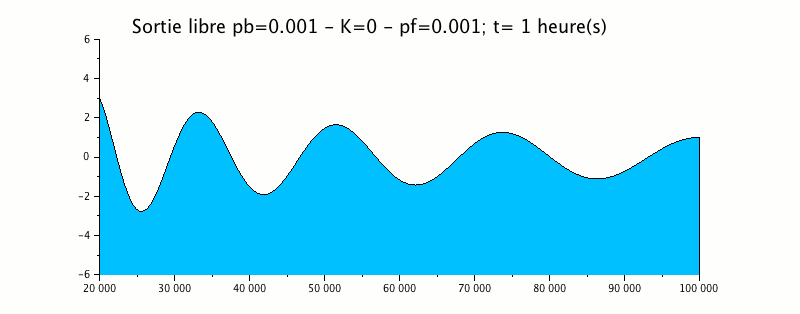
|

|
This example shows that the wave generated downstream (right on the diagram) with an amplitude of 1m propagates upstream (left) while deforming: decrease of the wavelength, increase of the amplitude.
At the left end, this wave leaves the domain without generating a reflection wave, which validates the free output condition used here.
The term shoaling introduced is of an order of magnitude less than the term eikonal and produces no significant change in the exit of the wave.
Moreover, the envelope curve clearly shows an amplification of the signal in the upstream direction.
Configuration n°2 : estuary without roughness - reflection of a wave inside the domain : linearly converging banks and sloping bottom
Let's introduce the following boundary conditions, which correspond to :
- a downstream boundary condition which generates an entering wave inside the domain from the right $ h(x_1,t)=A_1(x_1,t) e^{-i\sigma t}\quad\forall t $
- an upstream total reflective boundary condition $ u(x)=0 \quad\forall t $
We get the following system :
$ \begin{cases} c_1 J_{2}^0+c_2 Y_{2}^0 =0 \\ \\ c_1 J_{1}^1+c_2 Y_{1}^1 =A_1 \sqrt {x_1} \end{cases} $
Whose resolution leads to:
$ \begin{cases} D= J_{2}^0 Y_{1}^1 - J_{1}^1 Y_{2}^0 \\ D_{c_1}=-A_1\sqrt x_1 Y_{2}^0 \\ D_{c_2}=A_1\sqrt x_1 J_{2}^0 \\ c_1=D_{c_1}/D \qquad c_2=D_{c_2}/D \\ h(x,t)=\Re \Bigl(\left \dfrac{1} { \sqrt x} [ c_{1} J_{1} (2k_f \sqrt x)+c_{2} Y_{1} (2k_f \sqrt x) \right] e^{-i\sigma t}\Bigr) \\ u(x,t)=\Re \Bigl( i\sigma \dfrac{ 1} { k_f} \dfrac{x_0} { H_0} \dfrac{1} { x} \left[ c_{1} J_{2} (2k_f \sqrt x) + c_{2} Y_{2} (2k_f \sqrt x) \right] e^{-i\sigma t}}\Bigr) \end{cases} $
We verify that $ h(x_1,t) = A_1 e^{-i\sigma t} $
'Application case: reflection of a sinusoidal wave'
The same case as above is used, but imposing a total reflection boundary condition. In this case, a reflected wave of the same period, the same amplitude but opposite direction of propagation is superimposed on the incident wave. This is equivalent as to impose twice the amplitude of the incident wave at the "sea" boundary.
[[ ]] ]]
|
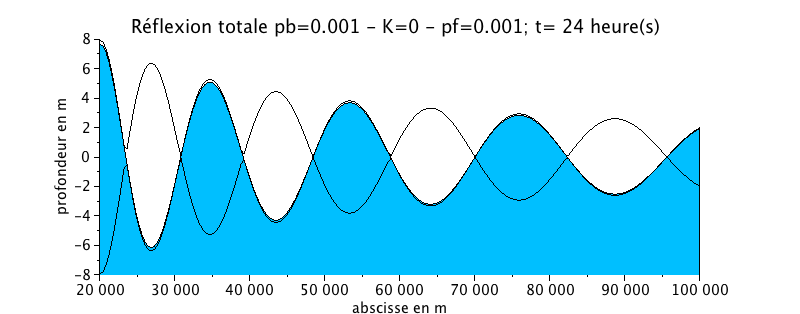
|
This animation shows the formation of regular crest and troughs which represents a total reflection.
The wavelength decreases progressively upstream as a function of the height of water. There is also an increase in the amplitude upstream.
Thus, in the absence of any friction, the wave propagates without loss of energy under the effect of the contraction of the banks and the slope of the bottom (to be compared with the similar case without slope where no deformation is observe).
Comparaison with numerical model TELEMAC2D
Propagation d'une onde dans un estuaire à pente... par Wikhydro
Configuration n°3 : HYPERSYNCHRONE ESTUARY with roughness / K=80
We take the previous case of the wave propagation with a radiation condition, but we add a little roughness in the form of a Strickler coefficient of 50.
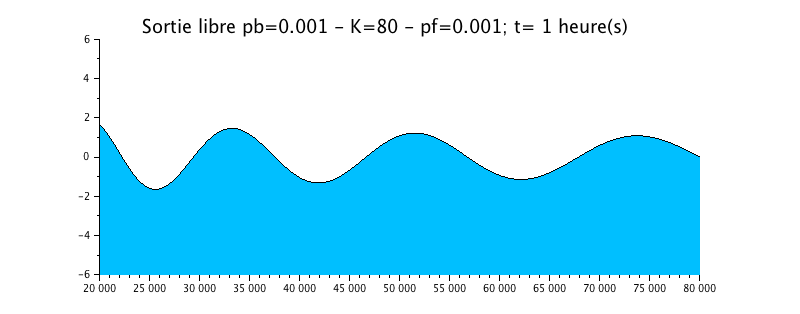
|

|
The animation shows a effective but small effect on the evolution of the water level. This one is still slightly damped compared to the solution without friction (configuration n ° 1).
The envelope curve shows the signal amplification effect upstream (left)
Configuration n°4 : Estuaire HYPOSYNCHRONE avec frottement / K=50
Nous avons repris le cas précédent de la propagation de l'onde avec une sortie libre, mais nous lui avons rajouté un peu plus de frottement sous la forme d'un coefficient de Strickler de 50.
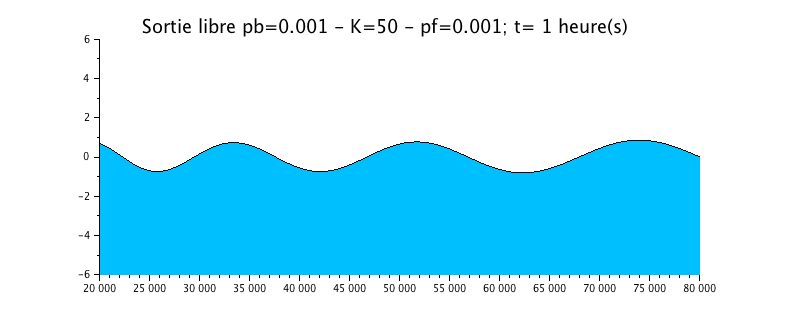
|
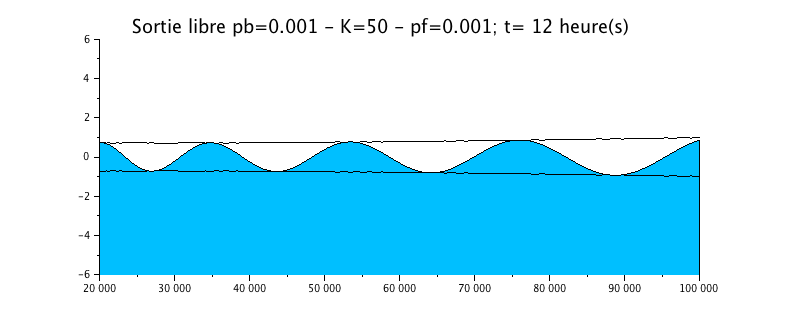
|
L'animation montre un effet certain, plus important que dans le cas précédent sur l'évolution du niveau d'eau. Celui-ci est beaucoup plus amorti par rapport à la solution sans frottement (configuration n°1).
La courbe enveloppe montre une nette atténuation du signal vers l'amont, ce qui rend l'estuaire hyposynchrone.
Comparaison avec le code de calcul TELEMAC2D
Conclusion générale sur la simulation de la propagation d'une onde dans un estuaire à pente du fond constante et à section constante
Les travaux qui ont été à l'origine de ce papier ont permis de dériver les équations susceptibles de représenter l'entrée d'une onde dans un estuaire caractérisé par un fond en pente linéarisée ascendant vers l'amont et un gabarit dont les berges convergent linéairement également vers l'amont.
Plusieurs enseignements peuvent être tirées de ces résultats:
- les conditions limites de sortie libre de Sommerfeld donnent toutes satisfactions : l'on sort sans générer en interne du domaine des ondes de réflexion
- la condition de réflexion totale imposée en fond d'estuaire représente donc bien le phénomène par la solution analytique. Par contre, l'utilisation du code numérique génère également une onde de réflexion à l'intérieur du domaine qui vient se superposer à la condition limite amont et nuit à la restitution correcte, allant même jusqu'à faire exploser le modèle. Un remarque est ici nécessaire sur ce que l'on représente exactement avec la solution limite. Si l'on veut représenter la superposition de l'onde incidente et de l'onde réfléchie, il faut doubler l'onde à la condition limite. Ainsi, on voit ici que l'enrichissement des 2 méthodes est réciproque.
- la prise en compte d'un frottement est également fort instructif. Tout d'abord, il faut rappeler que sans frottement, l'estuaire est HYPERSYNCHRONE, du fait de sa pente ascendante et de son gabarit rétréci. Si l'on rajoute un peut de frottement (K=80), l'onde diminue, ce qui est bien conforme à la théorie.Par contre, si le frottement augmente, le train d'onde est beaucoup plus écrasé en amplitude, amenant même l'estuaire à devenir HYPOSYNCHRONE.
Bibliographie
- Le Méhauté B., "An Introduction to Hydrodynamics & Waterways" Springer-Verlag, 1976, 315 p.
- Thual O., "Hydrodynamique de l'environnement", Les éditions de l'Ecole Polytechnique, Oct. 2011, 314 p.
- Dinguemans M. W., "Water Wave Propagation Over Uneven Bottoms - Part 1 - Linear Wave Propagation", Advanced Series on Ocean Engineering - Volume 13, World Scientific, 471 p.
- Dinguemans M. W., "Water Wave Propagation Over Uneven Bottoms - Part 2 - Non-Linear Wave Propagation", Advanced Series on Ocean Engineering - Volume 13, World Scientific, 494 p.
- Tanguy J.M. "Traité d'hydraulique environnementale", vol.2, "processus maritimes", reps. publi. JM Tanguy, Ed. Hermès - Lavoisier, 2010.
- site du SHOM et plus particulièrement une page dédiée aux courants de marée
- D. Prandle and M. Rahman, "Tidal Respo,se in Estuaries" Journal of the Physical Oceanography, Vol. 10, pp 1552 - 1573, 1980
Code Scilab
Les animations précédentes ont été réalisées à l'aide le l'application SCILAB.
Elles peuvent être utilisées pour reproduire le graphique. Il suffit de sélectionner l'ensemble du texte dans le fichier *.pdf et de le copier dans l'éditeur du logiciel puis d'exécuter le programme.
Le fichier est disponible ici : Fichier:Estuaire avec correction.pdf fournit le code SCILAB du programme qui fournit les animations précédentes.
Note : d'autres personnes peuvent avoir contribué au contenu de cet article, [Consultez l'historique]. |
 S'abonner à un flux RSS
S'abonner à un flux RSS
